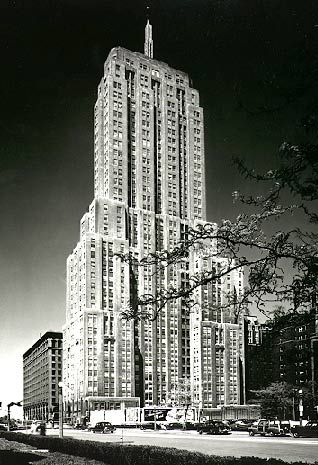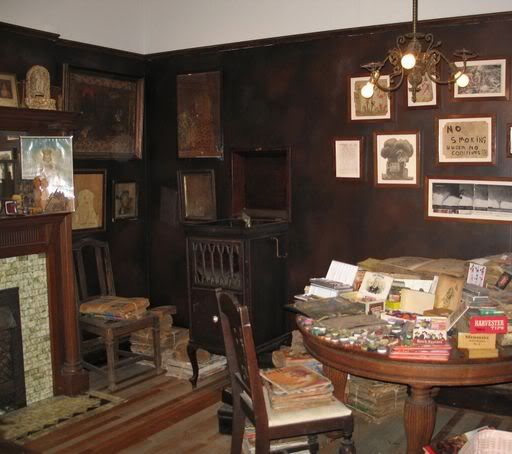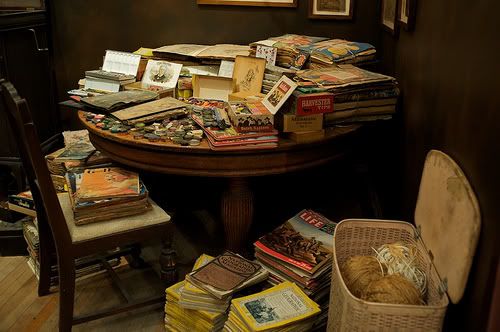HENRY JOSEPH DARGER
(12 April 1892-13 April 1973):
"I HAVE ALWAYS WANTED TO BE A CHILD AND HERE I AM
A LAME OLD MAN—DARN IT!"
This book is compiled with two series of photographic records: Keizo Kitajima accompanied Inuhiko Yomota to cover Darger’s apartment for the magazine Asahi Journal in 1999, the very last time the room was photographed before its contents were removed. Kiyoko Lerner kindly let us use the old photos from the 1970s, rare images taken when the apartment was being cleaned not long after Darger’s death.
These photos show the apartment where the elderly outsider artist Henry Darger (1892-1973) spent the last forty years of his life, almost until he died on 13 April 1973, a third-floor backroom of a townhouse on Webster Avenue in Chicago.
Henry’s room was on the third floor. It was filled with STUFF from floor to ceiling. There were stacks of newspapers, magazines, and empty bottles of Pepto Bismol. It appeared as though every single thing he had brought into the room in the forty years he had lived there had never left the room. There was hardly any space left to walk around.
Henry looked like a street person. He was very shy and never looked at you when you saw him on street and said “hello”…. Henry did look very dirty and uncared for not to mention the strange look in his eyes. He also always wore the same military overcoat which was greasy-looking and came down all the way to his ankles.
Whomever could have imagined that once he entered his room, this dirty, shuffling old man wrote and painted another world into being? …. None of us could make heads or tails of all this JUNK and the great mystery that we uncovered from Henry’s room.
Kiyoko Larner (landlord)

August 4, 2009
review and reflections by Scott Ferry
Having just returned from visiting Chicago I am left with many deep impressions, but the one that sticks the deepest for me is visiting the Intuit : The Center for Intuitive and Outsider Art. (http://www.art.org/ ) I specifically had set in my mind when I was leaving for Chicago that I would specifically go and see the exhibit of Henry Darger’s Room.
I arrived in the city overwhelmed by the vast and monumental Neo Classical style buildings, art deco and Gothic detailing, remnants of Masonic lodges, and White City. I am not an expert in architectural history, but nevertheless I was in awe. The city was a good mix of new and old, gritty and clean. There is definitely a presence in the city, maybe from memories of Saint Valentine's Day Massacre, Dr. Henry Howard Holmes, or the Victorian haunts of Graceland or Rosehill cemeteries. Even if I look at my impressions now of what I felt and saw, there is something with me.. a hauntedness that lingers on.. old cities have this feeling, something that will not let go.
All of this set the atmosphere for the easy CTA ride down to 756 N. Milwaukee Avenue. I was not sure what to expect with regards to seeing Henry’s room recreated in a museum setting, but I knew intuitively I would sense something powerful for sure. When I arrived I had a hard time not rushing to see that exhibit in particular.. so I made myself patient as if I was opening a gift slowly by looking at each of the other outsider artists on display.
At the entrance to the room is one of Darger’s original panoramic works. In close-up viewing you can feel the raw edge and power he poured into his creations. All that thought, nightmare and reason. I lingered in the small corridor where they had pictures of the original room and writing about his life, recollections from people who knew him, and observations.
One thing I have noticed in studying Henry Darger is that you have to really delve into it to gain a complete pictures and understanding of his world. One overview, video or a book is definitely not enough. Most of the writings have not been published, so the comprehension we have to go with his images are scattered and fragmented and leave a large mystery left only to the researched who can truly dive into them. For most people, our vision of Darger is screened and filtered by the presentations we are given. That is unfortunate. Nevertheless I am heavily grateful for when new presentations of his life and work appear. It is exciting and we gain a new glimpse.
I turned to my left and there was the recreated room, everything but the floorboards were original. A couple of the Vivian girls hung in frames around an alter of statues and photos surrounding a fireplace. The Catholic images mixed with little girl photos and pictures. The first impression I got from the Vivian girl portraits was not the childlike quality at first, but rather the commanding looks. These were not simple little children, but in this room they were gods and they seemed to hold power over everything they gazed upon. This impression lends me to feel that Henry Darger in his stories was really torturing the children as a way to build them into martyrs and then immortal gods holding sway over the largely Catholic greater world. Here was his sense of justice, but also a spiritual rising above the suffering for his immortalized angels. I would have loved to know what he was saying in his room to these creatures of his imagination and importantly what did they say back.
The room is very well presented, stacks of paints, cutout images, magazines (notably National Geographic), and images on the walls that represents his inspiration, fear and also motivation. The museum chose interestingly enough to put a set of image of a tornado (bad weather) on the wall, considering he was obsessed with the weather. The old typewriter, or one of them that he used to type his legal size single spaced stories, was sitting on a table. I could feel the presence of this man who was largely neglected all his life and lived through another world. This world seeming to reject him and the other world where he was basically god and servant, a perfect battleground for his tortured conscience.
I spent some time there dwelling on the whole experience and trying to find clues to match the missing pieces of what I knew of the artist.
The girl who was sitting at the gallery was courteous enough to give me some extra information which I hadn’t previously known and gave me even more urge to search out what I could of Henry’s world. The museum apparently had placed both books, The Story of the Vivian Girls, in What is known as the Realms of the Unreal, of the Glandeco-Angelinnian War Storm, Caused by the Child Slave Rebellion and Crazy House: Further Adventures in Chicago, on microfilm. The girl at the desk had read some of the stories from that and gave me some detailing. One thing she mentioned stuck out in my mind and gave me greater impetus to search out what I could find and hopefully one day, if graced by events I can actually read it, was the details she gave about her impressions of reading Crazy House.
Now if you don’t know the story, Crazy House is the second book Darger wrote in Chicago. It contains over 10,000 handwritten pages. Written after The Realms, it takes that epic's major characters—the seven Vivian sisters and their companion/secret brother, Penrod—and places them in Chicago, with the action unfolding during the same years as that of the earlier book. Begun in 1939, it is a tale of a house that is possessed by demons and haunted by ghosts, or has an evil consciousness of its own. Children disappear into the house and are later found brutally murdered. The Vivians and a male friend are sent to investigate and discover that the murders are the work of evil ghosts.
Her impressions of reading this were that it scared her badly. She said the descriptions of tortures are much more graphic then the first book and the haunted atmosphere makes the story even more chilling. This utterly fascinated me. Hopefully one day they can publish more of the works, even in edited form it is better then nothing at all which is what most of us are left with.
On leaving I purchased the Henry Darger Room book, published by 2008 by Imperial Press. A good document of what I had just seen.
The artists I would mention at the museum that were of interest were William Hawkins (1895-1990) and Elijah Pierce (1892-1984), plus works by lesser-known artists Mary Borkowski (1916-2008), Mary Frances Merrill (1920-1999), visionary Morris Ben Newman (1883-1980), David Pond (1940-2001).
I would highly recommend if you are in the area of Chicago or are stopping through to go see this exhibit.
- Scott Ferry
(August 4, 2009)
www.scottferry.com
1 comment:
I first discovered Darger while visiting the Musée de l'art brut in Lausanne. Of all I had the chance to see, it's the room dedicated to his work I remember the most. Although it was a fairly small exhibit of his unmeasurable production, I've spent hours there. Your perception the girls is fairly similar to mine. Amazing text!
Post a Comment